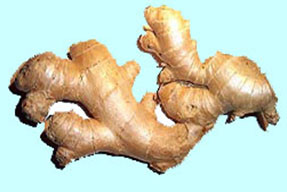Kahili ginger (wild ginger)
|
|
|
|
|
|
Wild ginger is a plant that is threatening our native bush. It is an introduced plant that is grown in some home gardens. It has colourful strongly perfumed flowers that produce up to 100 seeds per flower head. The seeds are dispersed by birds. Wild ginger grows in the shade or sun and spreads very quickly creating a dense mat of plants. It has long horizontal underground stems, called rhizomes, which can produce new plants.

Source: Wikipedia.org



| Y8 (08/2006) | ||
| a) |
Lots of seeds E.g., Good chance some seeds will germinate/ lots of seedlings will be produced Rhizomes that can form new plants E.g., Can spread quickly/ another way of reproducing Grows quickly E.g., Smothers other plants/ reduces competition/ makes it hard to control Grows in sun or shade E.g., Good chance of surviving in different conditions |
easy moderate moderate easy |
| b) |
i. Because new plants can grow from these ii. To stop seed formation or dispersal/ to stop it spreading/ to protect the environment |
easy easy |
| a) |
Students who had difficulty explaining how the special features of wild ginger helped it survive tended to simply repeat either the information about the special feature, or parts of the text, as the explanation. In the case of the rhizomes we accepted answers that referred to reproduction as correct, even though many of these answers were simply repetition of information given. The reasoning behind this was the unfamiliarity of rhizomes at this level.
Two misconceptions about rhizomes were identified. Some students thought they served the same function as roots and gave the plant an advantage because they could reach water that was a long way away. Others thought the rhizomes allowed the ginger to strangle the roots of native plants. Many students said the feature "grows quickly" helped wild ginger because this also meant it matured quickly and therefore produced seeds quickly. This was counted as a correct response because it seemed to indicate logical thinking in a context where students would have little background information. |
|
| b) | i) | Several students in the trial suggested that wild ginger should not be burnt because it would cause smoke pollution rather than identifying this was an inefficient way of getting rid of the plants. |
| ii) | 24% of students mentioned it was important to destroy flowers because these turned into seeds, 18% said it was important to destroy flowers because this would stop growth and 35% gave a more general reason that mentioned saving native plants or protecting the environment. (These were all considered correct responses). | |
- Kahili ginger (wild ginger) requires students to retrieve information about Wild Ginger from written text.
- Old Man's Beard requires students to retrieve information about Old Man's Beard from written text and pictures.
- Couch - A type of grass requires students to retrieve information about Couch Grass from a diagram.
Both Kahili ginger and Old man's beard require responses to be recorded in tables. Kahili ginger provides the highest level of support. Teachers may choose to adapt the tables in the resources, by using changing assessment resource (see Change a resource) to make them more appropriate to the needs of students in their classes.
The resources could be used together to identify similarities in the special features of the different pest plants. All these plants have highly developed adaptations to ensure survival. Their ability to thrive puts other species at risk and this is why they are considered pests. Information on other pest plants is readily available on the websites listed below. Note: These pest plants are all introduced plants.
In order to understand how the plants' special features help them to survive, students will need to understand the basic structure and function of various parts of a plant.
Students could also explore ideas about interdependence and how changes in any element of the environment may affect the relationships between living things and lessen the chances of some species surviving.
The following websites give information about pest plants:
- http://www.doc.govt.nz/templates/summary.aspx?id=33500
- http://www.landcareresearch.co.nz/education/weeds/

